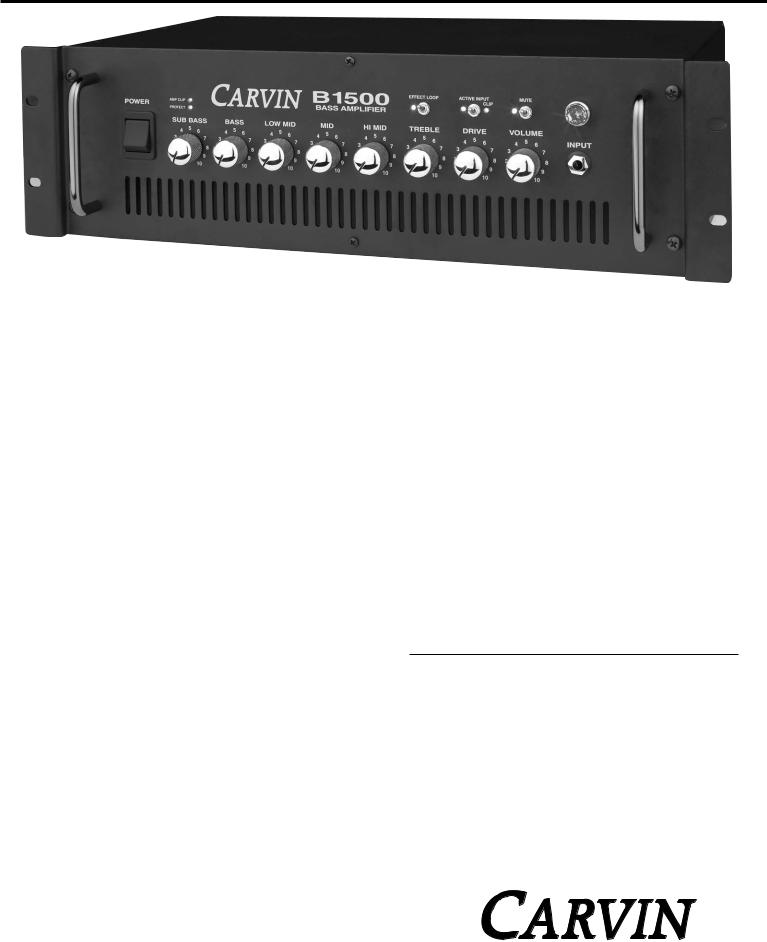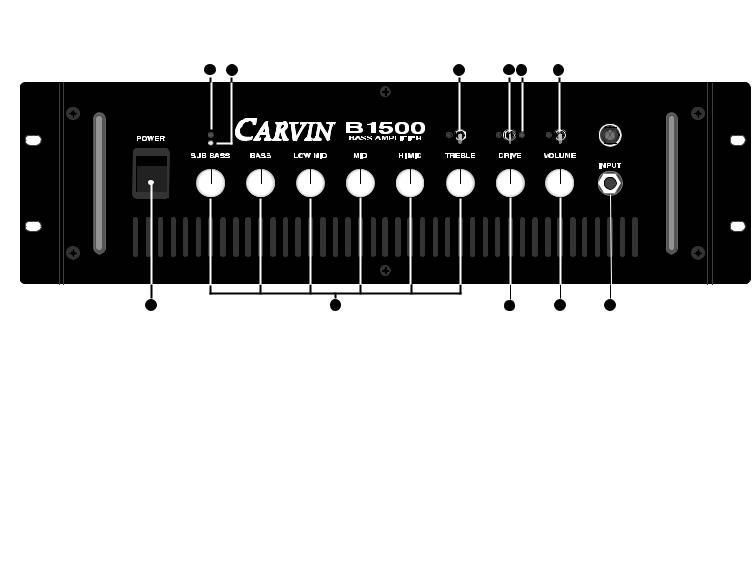Carvin B1500, B500 Owner's Manual

CARVIN ENGINEERING DATA
B500 / B1500 BASS AMPLIFIERS OPERATING MANUAL
The B1500 mono block bass head offers classic natural bass tone with the highest power headroom available in any bass amp to date. The B1500 delivers 700w at 8Ω, 1250w at 4Ωand 1900w at 2Ω. The B500 bulges with the same huge tone but delivers 225w at 8 ohms, 350w at 4Ω and 500w at 2Ω.
Four discrete Class A input stages produce the harmonic basis for the preamp right from the input jack. It begins with a boutique flat response, then we add 6 tone controls for you to carve out your signature sound. Harmonic content increases as you turn up the Drive control producing a growl at maximum settings. Solid design, bullet-proof construction and a list of indispensable features assure the B500 or B1500 will be the heart of your rig for years to come.
•Discrete Class A input stages
•Active/Passive input gain switch with input CLIP indicator
•Preamp DRIVE and master VOLUME controls
•Six EQ controls: SUB BASS, BASS, LOW MID, MID, HIGH MID, and TREBLE
•Signal MUTE front panel switch (also controlled by optional FS22 footswitch)
•EFFECT LOOP front panel bypass switch (also controlled by optional FS22 footswitch)
•DIRECT OUT balanced XLR with independent LEVEL control, switchable "Pre-Post" and "Ground Lift", DC isolated
•TUNER output jack independent of MUTE switch
•Internal OPTO (optical isolation) clip-activated power amp limiter with “limiter free” normal operation
•High current SPEAKON® connectors and 1/4” speaker jacks
•Metal shaft controls with threaded metal bushings mounted directly to front panel
•19" 3U all steel chassis
GETTING STARTED QUICKLY
If you are like most players, you probably want to plug in your new amp and get started playing right away. Before you start, be sure your amp is plugged into the correct AC voltage.
1.With POWER off, connect a speaker cabinet to one of the rear SPEAKER OUTPUTs.
2.Set the VOLUME and DRIVE to “0” and set the ACTIVE INPUT switch for your type of bass.
3.Set all tone controls to their center “5” position. This is the “FLAT” setting for the amp.
4.Now, turn the amp ON. Turn the output level of the bass guitar fully up. Gradually increase the amp VOLUME control to the desired level. If no sound is heard, turn down the VOLUME control and check the MUTE and PROTECT LEDs.
5.Increasing the DRIVE control will add harmonic richness to your sound. Turning up the DRIVE also increases volume. Re-adjust the VOLUME after adjusting the DRIVE.
6.Adjust the tone controls to your liking. Keep in mind that turning up a tone control isn’t always the answer. Sometimes turning down one of the MID controls will get you the sound you want. Depending on your speakers you may get more volume and clearer bass from your cabinet by lowering the SUB BASS control and increasing the BASS or LO MID control.
7.Need more volume? There is a limit to the amount of volume a speaker can produce and driving a speaker beyond it’s limit can damage it. Even though the B1500 is a powerful amp, adding more speakers is the only way for substantially more output. Every time you double your speakers, you increase your acoustic output by a factor of four.
Hopefully, this will help you get started. Have fun exploring the features and sounds of the B500/B1500. Take the time with your new amp to realize it’s full potential - and yours!
DESIGNED FOR THE RIGORS OF TOURING
The B500 & B1500 are constructed using a heavy-duty 16 gauge steel chassis and a 12 gauge steel front panel that are galvanized to prevent rust. Connections include Speakon® output connectors and a full featured XLR Direct Out. Controls feature metal shafts and threaded metal bushings mounted to directly to the front panel. All internal cabling is securely tied and harnessed. Every circuit card is MIL SPEC, double-sided, through-hole plated, fire retardant FR-4 glass epoxy. Toroid transformers are used as they are the engineer’s choice for greater power supply current while reducing weight and magnetic “hum” fields.
RECEIVING INSPECTION—read before getting started
INSPECT YOUR UNIT FOR ANY DAMAGE which may have occurred during shipping. If any damage is found, please notify the shipping company and CARVIN immediately.
SAVE THE CARTON & ALL PACKING MATERIALS. In the event you have to re-ship your unit, always use the original carton and packing material. This will provide the best possible protection during shipment. CARVIN and the shipping company are not liable for any damage caused by improper packing.
SAVE YOUR INVOICE. It will be required for warranty service if needed in the future. SHIPMENT SHORTAGE. If you find items missing, they may have been shipped separately. Please allow several days for the rest of your order to arrive before inquiring.
RECORD THE SERIAL NUMBER on the enclosed warranty card for your records. Keep your portion of the card and return the portion with your name and comments to us.
USA customers register online at: www.carvin.com/registration
All other countries register online at: www.carvinworld.com/registration
B500/B1500 SPECIFICATIONS:
MODEL |
B500 |
B1500 |
|
Output Power |
|
|
|
8Ω, |
THD <1.0% |
225w |
700w |
4Ω, |
THD <1.0% |
350w |
1250w |
2Ω, |
THD <1.0% |
500w |
1900w |
Input Impedance: |
|
>200K |
Tone Controls: |
±12dB @ 30, 100, 300, 1k, 3k, 10k (Hz) |
|
Drive Control: |
Varies input gain and harmonic content |
|
AC Requirements: |
120VAC 60 Hz or 240VAC 50 Hz optional models |
|
Power Requirements: |
B500: 500VA, B1500: 1900VA |
|
Dimensions (no cabinet): (3U) |
5-1/4”H x 19”W x 10”D |
|
Weight : |
B500: 25 lbs. |
B1500: 35 lbs net wt. |
Warranty: |
One year parts and labor |
|
76-41500B 051304

FRONT PANEL CONTROLS
10 |
5 |
LOOP
5 |
6 |
|
4 |
5 |
6 |
4 |
5 |
6 |
|
4 |
5 |
6 |
|
4 |
6 |
|
4 |
6 |
4 |
6 |
|
7 |
3 |
|
|
7 |
3 |
|
|
7 |
3 |
|
7 |
3 |
|
7 |
3 |
|
7 |
3 |
7 |
|
|
1 |
|
|
|
1 |
|
|
|
1 |
|
|
1 |
|
|
1 |
|
|
1 |
|
|
10 |
|
0 |
|
10 |
0 |
|
10 |
|
0 |
|
10 |
|
0 |
10 |
|
0 |
10 |
0 |
10 |
11 |
7 |
1 |
1. INPUT JACK
The 1/4” INPUT jack accommodates both passive and active instruments. The high impedance Class A input stage offers enough headroom to perform without clipping even when used with high output active basses. Input is adjusted with the DRIVE control (6) and the ACTIVE INPUT switch (5).
2. VOLUME CONTROL
The VOLUME control adjusts the output level to the speakers. Adjusting the DRIVE control will also change your output level.
3. MUTE SWITCH / LED
The MUTE switch will stop all output signals with the exception of the TUNER and EFFECT SEND signals. The MUTE function can also be remotely controlled from the rear FOOTSWITCH jack using the optional FS-22 footswitch. The blue LED next to the MUTE switch will light whenever the amp is muted. The footswitch will have no effect if the front panel MUTE switch is on in the UP position.
4. CLIP LED |
|
The red CLIP LED indicates that the |
is near clipping. Since the B1500/B500 preamp is |
designed with several Class A input |
stages and the ability to be overdriven, the CLIP LED |
monitors only the first input stage and will not indicate when the DRIVE control is set to overdrive the preamp. To avoid input clipping, reduce the bass level or reduce the output level of devices placed between the bass and the input jack.
5. ACTIVE INPUT SWITCH / LED
The ACTIVE INPUT switch is used to match the input gain of the amp to instruments that contain active electronics. If the preamp is being prematurely overdriven, flip the ACTIVE INPUT switch to the ON position. If the output of your bass is low and you are not getting enough volume from the speakers, be sure the ACTIVE INPUT switch is OFF and increase the DRIVE control. The blue LED indicates that the ACTIVE INPUT mode is ON.
6. DRIVE CONTROL
The DRIVE control adjusts the input gain to the preamp and the level of harmonics in the signal. With the DRIVE control set low, both input gain and harmonics are at a minimum for clean output. Increasing the DRIVE control causes the Class A gain stages to introduce more harmonics resulting in a rich sound typical of vintage tube amps. With the DRIVE control set near maximum, overdrive sounds can be produced. The DRIVE control can be used with the ACTIVE INPUT switch to get the sound you want. To reduce preamp overdrive while retaining the harmonics of a high DRIVE level setting, turn the ACTIVE INPUT switch ON or reduce the level on the bass guitar. Turning the ACTIVE INPUT switch OFF will make the preamp overdrive easier.
7. TONE CONTROLS
The six TONE CONTROLS on the B500/B1500 are designed with the center frequencies most requested by professional bass players. To start, set each control at its center flat position (no tones are cut or boosted). Raise or reduce each control to get your desired tone.
The SUB BASS control is centered at 30Hz. The BASS control is centered at 100Hz. The LO MID control is centered at 300Hz. The MID control is centered at 1kHz.
The HI MID control is centered at 3kHz. The TREBLE control is centered at 10kHz.
8. EFFECT LOOP SWITCH / LED
The EFFECT LOOP switch engages the rear effects loop connections. The effects loop can be turned on with the EFFECT LOOP switch on the front panel or by using the optional FS22 footswitch. When the front panel switch is in the UP position, the loop is engaged regardless of the footswitch. The status of the effects loop is indicated on the front panel by the BLUE LED next to the EFFECT LOOP switch.
See EFFECT LOOP SEND/RETURN JACKS #13.
9. AMP CLIP LED
The AMP CLIP LED indicates that the power amp is being driven too hard. Reduce the volume level.
10. PROTECT LED
The PROTECT LED indicates that the power amp has gone into one of it’s protect modes.
11. POWER SWITCH / (PROTECT RESET)
Push the upper portion of the POWER SWITCH to turn the amplifier on. If the large blue power indicator is on but no sound is coming out of the speakers, the amp may have gone into one of its protection modes. To reset the amp, turn the power off for 30 seconds and then turn the amp back on. If the problem persists, check for; a) The speaker impedance is too low for the amp, b) bad speaker cable, c) damaged speaker or, d) blocked rear fan intake.
HELPFUL HINTS
1)NO SOUND FROM AMP: The MUTE function has been inadvertently engaged, speakers have been improperly connected or Effect Loop has been improperly connected.
2)NO HIGH FREQUENCIES: Tweeters or midrange drivers have been damaged from too much power.
3)WEAK BASS: The speaker systems are wired out of phase to each other. To correct, reverse the wires on one of the speaker connectors.
4)DIR XLR HUM: Try switching the rear GND LIFT switch IN or OUT. Check for noise from external effects or bad cabling.
